
Catalog excerpts

FlowMaster Time-Resolved Particle image Veloeimetry Systems
Open the catalog to page 1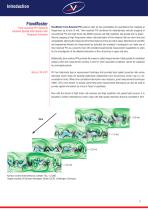
Time-resolved PIV Systems combine Spatial Information with Temporal Evolution FlowMaster Time-Resolved PIV systems open up new possibilities for quantitative flow mapping at frequencies up to tens of kHz. Time-resolved PIV combines the instantaneous velocity mapping of conventional PIV with high frame rate CMOS cameras and high repetition rate pulsed and cw lasers. Velocity mapping at high frequencies allows characterization of flow features that are short lived and unrepeatable, allowing the measurement of flow features in time as well as space. Most flows of scientific and engineering...
Open the catalog to page 2
TR-PIV Operating Modes In TR-PIV two operating modes are possible. Each have distinct advantages and the mode selected depends on the experimental conditions as well as the specific motivation (i.e. usage) for the data. Time Series Mode (TSM): In this mode, a single laser pulse is fired in each camera frame. From each pair of neighbour images a vector field is computed so that the camera frame rate is equal to the vector field acquisition frequency facq. The acquisition rate facq should be selected such that the resulting time between laser pulses Δt = 1/ facq is adequate for the flow...
Open the catalog to page 3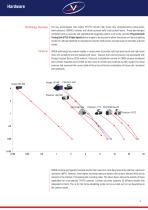
Technology Overview The key technologies that enable TR-PIV include high frame rate complementary-metal-oxidesemiconductor (CMOS) cameras and diode pumped solid state pulsed lasers. These technologies combined with an accurate and sophisticated triggering system such as the LaVision Programmable Timing Unit (PTU) X High-Speed allows images to be acquired in either time series or frame straddling modes for ultimate flexibility to characterize velocity fields across a broad range of velocities and time scales. CMOS technology has evolved rapidly in recent years to provide both high pixel...
Open the catalog to page 4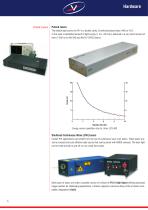
Pulsed Lasers Pulsed lasers The default light source for PIV is a double cavity, Q-switched pulsed laser (YAG or YLF). In this case a substantial amount of light energy (1 mJ - 50 mJ) is delivered in a very short amount of time (7-200 ns for Nd:YAG and Nd:YLF DPSS lasers). Energy versus repetition rate for Litron LDY-300 Shuttered Continuous Wave (CW) lasers Certain PIV applications can benefit from the use of continuous wave (cw) lasers. These lasers provide a compact and cost-effective light source that can be paired with CMOS cameras. The laser light can be freely turned on and off on...
Open the catalog to page 5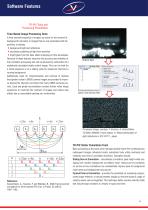
TR-PIV TooIs and Processing Possibilities Time-Based Image Processing Tools A time-resolved sequence of images can allow for the removal of background luminosity in images that are not associated with the particles, including: 4 background light and reflections 4 secondary scattering of light from particles 4 bright glare from the laser sheet impinging on flow boundaries Removal of these features improves the accuracy and reliability of the correlation processing and can be achieved by subtraction of a statistically calculated stable control image. This can be fixed for a whole sequence or...
Open the catalog to page 6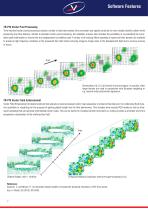
Software Features TR-PIV Vector Post Processing Time-resolved vector post-processing includes a variety of tools that employ time correlation and spatial continuity to more reliably identify outliers while preserving true flow features. Similar to standard vector post processing, the validation process also includes the possibility of re-evaluating the correlation peak information to recover the true displacement correlation peak. A variety of de-noising filters operating in space and time domain are available to preserve high frequency variations in the measured flow field while removing...
Open the catalog to page 7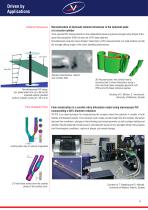
Coherent Structures Reconstruction of dominant coherent structures in the turbulent wake of a circular cylinder Time-resolved PIV measurements on five independent planes are phase averaged using Proper Orthogonal Decomposition (POD) of each set of PIV data obtained. Simultaneously acquired Laser Doppler Velocimetry (LDV) measurements at a fixed location provide the average oblique angle of the vortex shedding phenomenon. Sample instantaneous velocity and vorticity field. Two-dimensional PIV setup: low speed water flow (U ≈ 85 mm/s) imposed velocity gradient uniform cylinder model (D = 25.4...
Open the catalog to page 8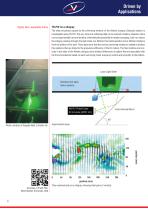
Driven by Applications Highly Non-repeatable Flows TR-PIV on a stingray The wake structures caused by the swimming motions of the Atlantic stingray (Dasyatis sabina) is investigated using TR-PIV. The very nature of collecting data on live animals creates a situation where no two experimental runs are identical, eliminating the possibility for phase-averaging. Each run shows the stingray passing through the light sheet at a different horizontal position and a different distance from the bottom of the tank. These data show that the various swimming modes are related to distinct flow patterns...
Open the catalog to page 9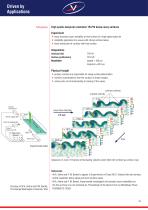
Driven by Applications Turbulence High spatio-temporal resolution TR-PIV below wavy surfaces Experiment 4study boundary layer instability at free-surface of a high-speed water jet 4instability generates mm-waves with strong vortices below 4study interaction of vorticity with free-surface Diagnostics Velocity field TR-PIV TR-PLIF Surface profilometry Resolution spatial < 100 µm temporal = 62.5 µs Physical Insight 4primary vortices are responsible for steep surface deformation 4vorticity is generated by the free-surface in sharp troughs 4vortex pairs are formed leading to closing of the waves...
Open the catalog to page 10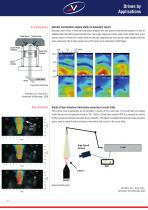
Driven by Applications IC Engine Flows Intake Valve Boundary layer flows in internal combustion engines are very poorly understood because of a lack of detailed high-resolution experimental data. The image sequence shows eight vector fields (only every second vector is shown for clarity) with the velocity magnitude as the colored image background that were measured with a high-speed micro-PIV setup at the University of Michigan. Exhaust Valve Quartz Piston Windows Internal combustion engine study on boundary layers Quartz Side Windows Quartz Cylinder Laser Sheet Experimental setup Courtesy...
Open the catalog to page 11All LaVision GmbH catalogs and technical brochures
-
Focus on Fluid Dynamics
12 Pages
-
Focus on Combustion
16 Pages
-
StrainMaster
20 Pages
-
FlowMaster
16 Pages
-
PIV poster
1 Pages
-
Particle Image Velocimetry
1 Pages
-
LIF poster
1 Pages
-
Tomographic PIV
20 Pages
-
StrainMaster Portable
8 Pages
-
StrainMaster Micro-DIC
8 Pages
-
SprayMaster
16 Pages
-
ParticleMaster
4 Pages
-
Optical Crack Tracer
4 Pages
-
MTZ 06/2013, Berg et al.
6 Pages
-
ICOS
12 Pages
-
DaVis
20 Pages
-
Laser Imaging in Fluid Dynamics
12 Pages
-
Quantitative Flow Field Analysis
12 Pages
-
Fluid-Structure Interaction
2 Pages
-
Imager sCMOS
2 Pages
-
Imager M-lite 2M
2 Pages

























